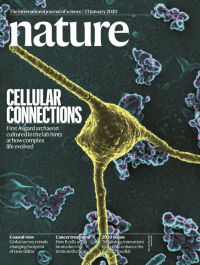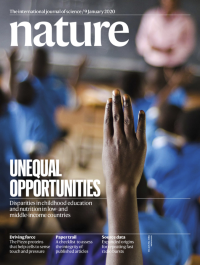Volume 577
-
No. 7792 30 January 2020
Mapping the futureReward prediction errors are part of the brain’s learning process. They account for the difference between the expected and the actual outcome of an event. The neurotransmitter dopamine is intimately involved in this form of learning — dopamine neurons tend to show increased activity when the outcome of an event is better than expected, but their activity decreases when the outcome is worse than predicted. As a result, learning has been viewed as the brain assessing the likely mean outcome as the basis for predicting the outcome of future events. In this issue, Will Dabney and his colleagues suggest that the picture is more complex. Taking inspiration from distributional reinforcement learning in artificial intelligence, the researchers analysed neuronal recordings from the mouse midbrain and found that instead of the brain representing the future as a single mean, it uses a probability distribution, effectively considering multiple possible future rewards simultaneously.
-
No. 7791 23 January 2020
Cellular connectionsComplex life forms, from plants to animals, are eukaryotes: their cells feature internal compartments such as the nucleus that are themselves contained within an internal membrane. But the origins of eukaryotes remain unclear. In this week’s issue, Hiroyuki Imachi, Masaru K. Nobu and their colleagues introduce a single-celled microorganism that could help to shed light on the evolutionary pathway that gave rise to early eukaryotic cells. For the first time, the researchers have managed to culture and isolate a member of the Asgard archaea, a group of microbes thought to be the closest living ancestors of eukaryotes. The team named the archaeon ‘Candidatus Prometheoarchaeum syntrophicum’ and found that it grows very slowly, doubling in number every 14–25 days, and it requires a microbial partner to support its growth. Intriguingly, the microbes often have branching protrusions on their outer surface, as shown in the cover image. It is possible that such protrusions could have enabled ancient archaea to grab passing bacteria, which were then internalized and eventually evolved into membrane-bound components, such as the mitochondrian, setting the stage for complex life forms.
-
No. 7790 16 January 2020
Border controlMany properties of nanocrystal materials are affected by surface defects called grain boundaries — the interfaces between individual crystallites, or grains, in the structure. The wide variation in size, shape and orientation of the grains makes it hard to understand how the defects influence the material’s properties. In this week’s issue, Taeghwan Hyeon and his colleagues demonstrate a method for synthesizing multigrain nanocrystals with uniform grain boundaries. The researchers demonstrate their technique by controlling the deposition and growth of Mn3O4 shells on each face of a Co3O4 nanocube crystal (the resultant structure is shown on the cover). The team identifies four design principles that should allow a wide range of multigrain nanocrystals with controlled grain boundaries to be prepared, opening fresh routes to probe the effects of the defects.
-
No. 7789 9 January 2020
Unequal opportunitiesNutrition is a key determinant of childhood morbidity and mortality. Similarly, educational attainment is a critical determinant of child health. In this week’s issue, Simon Hay and his colleagues present two papers that offer high-resolution subnational mapping of child growth failure and educational attainment between 2000 and 2017 for around a hundred low- and middle-income countries, from Africa to the Middle East, Asia and South America. The researchers find that although there has been significant progress in both areas, considerable geographical inequalities remain in many countries. Although child potential is everywhere, opportunity is not.
-
No. 7788 2 January 2020
Keeping trackOne hundred and ninety-three countries have committed to the United Nations’ 17 Sustainable Development Goals (SDGs). These goals cover a range of issues including poverty, gender equality and climate change. To date, it has been difficult to assess spatio-temporal progress towards achieving the SDGs. In this week’s issue, Jianguo Liu and his colleagues present systematic methods that can be used to quantify progress towards the goals at multiple organizational levels over time. The researchers demonstrate their methods using China as a test case, finding that the scores for 13 of the 17 goals had improved nationally over the period 2000 to 2015, while revealing regional differences within the country.





